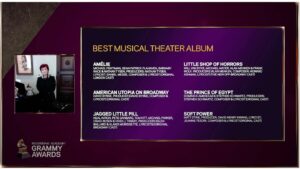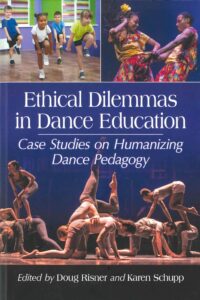
Inaugural Winner of Stinson Award Announced
The University of North Carolina Greensboro School of Dance is delighted to announce the inaugural recipient of the UNCG | Susan W. Stinson Book Award for Dance Education to Doug Risner and Karen Schupp for the edited volume Ethical Dilemmas in Dance Education: Case Studies on Humanizing Dance Pedagogy (Palgrave MacMillan, 2020). Comprised of research-based, fictionalized case studies contributed by leading experts in dance education, the book examines real-world scenarios that call for dance educators’ ethical decision-making. The first book of its kind in dance investigates ethical dimensions of the dance studio, stage, classroom, community center, and social media contexts.
The 2021 award selection committee noted, “Ethical Dilemmas in Dance Education is a superb edited collection of case studies that will transform dance teacher training by unpacking and asking key ethical questions. One of the most powerful and pedagogically profound aspects of the book includes reflective activities for developing humanizing dance pedagogies by revealing the complex nature of ethical decision making in dance teaching and education.”
Dr. Doug Risner is professor of dance, distinguished faculty fellow at Wayne State University and an alumnus of UNCG (BFA, 1988; MFA, 1991; PhD, 2001). Karen Schupp is assistant director of dance and associate professor in the Herberger Institute School of Film, Dance and Theatre at Arizona State University
Evaluation of nominated books centered upon assessment of the text’s originality, critical rigor, innovation, and potential contribution to the field of dance education with particular attention to books that engage, challenge, question, motivate, and support dance educators across education sectors and diverse populations.
About the Award
Funded by an anonymous donor to UNCG in recognition of Dr. Susan W. Stinson—a leading pioneer in the field of dance education—the annual award recognizes book-length publications of excellence in dance education during the current and previous year and honors scholars and researchers who conduct and disseminate exemplary inquiry that advances the field of dance education. The award’s recognition contributes significantly to the visibility of dance education professionals and their work, as well as the vitality of outstanding dance scholarship and publication excellence. The deadline for nominations occurs annually in late December with award decisions determined by early March of the following year.
About Dr. Susan Stinson
Sue Stinson, Emeritus Professor of Dance, became a full-time faculty member in the Department of Dance at UNCG in 1979, having been recruited to develop the K-12 licensure program. She subsequently earned her EdD in Curriculum/Cultural Studies from UNCG in 1984.
Dr. Stinson served as Department Head in Dance 1993-2002 and undergraduate coordinator 2002-2012. During her tenure as Head, she led the Department to its first accreditation by the National Association of Schools of Dance. Dr. Stinson initiated the BA in dance and the MA in dance education, the latter delivered through online and summer courses. She served as Interim Dean of the School of Music, Theatre and Dance from July 2012 until her retirement in July 2013.
She has published her scholarly work in multiple journals and book chapters and has taught and presented her work throughout the USA and in a number of countries in the Americas, Europe, Asia, and the Pacific. Her research focused on both theoretical issues in dance education and how children and adolescents make meaning from their experiences in dance education. In addition, she is the author of two books, Dance for Young Children: Finding the Magic in Movement (1988), and Embodied Curriculum Theory and Research in Arts Education: A Dance Scholar’s Search for Meaning (2016).
An active member of her profession at the state, national, and international levels, Dr. Stinson played a key role in the initial and subsequent development of standards for K-12 dance education. Her international service has included a number of positions in Dance and the Child: International, as Chair, Research Officer, international conference co-chair, and Proceedings editor. She has also served on international advisory boards for publications in Dance and Arts Education. National awards include National Dance Association Scholar (1994), National Dance Education Organization Lifetime Achievement Award (2012), and Congress on Research in Dance award for Outstanding Scholarly Research in Dance (2012).
Since her retirement, she has engaged extensively in community-based activities related to social justice and other civic initiatives, creating a meaningful new chapter of her life.
Read more about the book, Ethical Dilemmas in Dance Education at https://www.google.com/books/edition/Ethical_Dilemmas_in_Dance_Education/I3nNDwAAQBAJ?hl=en&gbpv=1
Theatre Dye Room and Crafts Studio: Taking Costumes to the Next Level

In Greensboro’s historic College Hill neighborhood, you’ll find a recent addition to CVPA facilities. 326 Tate Street—where Addams University Bookstore once stood—is now home to the School of Theatre’s Costume Studio. Although technically not on campus, it’s very close, just down the block from Taylor Theatre and Sprinkle Theatre.
The Costume Studio is fascinating enough on its own with thousands of costume pieces on racks in the front room and a fleet of sewing machines humming in the back. But keep exploring, and you’ll find a specific area that is dedicated to theatre crafts, including the production of costumes and props for stage productions.
There, Costume Studio Supervisor Amy Holroyd and a group of design-tech students make the magic to take an actor’s wardrobe to the next level:
“This is an exciting space. It’s where we produce some of the more unusual costume pieces. From hats to footwear, wings to body padding. We dye fabrics, paint shoes, silkscreen and airbrush costumes. This is where we can get messy and not worry about the equipment. This studio space allows us to keep the paints and glues away from the sewing machines.”
The Dye Room is equipped with two industrial soup kettles, and a stove with an exhaust hood, which designers use to cook up just the right colors for a particular need on stage. There’s also a stower stall for drip drying, and a washer and a dryer for newly dyed fabrics.
Last semester, students created wings for a character in Marisol, which Amy says was a team project that made her proud:
“Allison Hines, who graduated in December with a BFA in Theatre Design and Technical Production designed the wings. Another student actually built them. Then practicum students spent hours upon hours dying each feather to the right grey and silver coloring.”
Currently in the Crafts Studio, students are working on Saint Joan by George Bernard Shaw, and the Spring MFA Theatre for Young Audiences Candidates’ One-Acts:
“Students are building suits of armour for Saint Joan, distressing fabrics, and painting emblems on shirts. One of the one-acts is a play by Mary Hall Surface titled Round Pegs, Square Pegs. The characters in that play have very distinctive hats, and students are getting experience building headwear in a variety of unusual shapes and sizes. They’re also working with thermoplastics and foams to make really fun things for the ‘Pegs.’”
Looks like the team in the Dye Room and Crafts Studio has UNCG actors covered from head to toe.

Amy Holroyd has been the Costume Shop Supervisor since 2010. She holds a BA in Theatre from UNC Charlotte and attended the Bristol Old Vic Theatre School in Bristol, England where she completed an intensive wardrobe curriculum earning the school’s Jean Healey Award.
Story by Terri W. Relos
Photography provided by Amy Holroyd and Triad City Beat
Instrument Repair Technician Keeps Students Playing
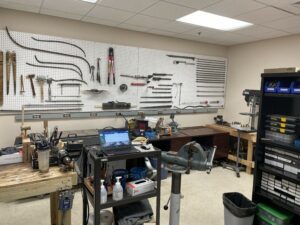
In the interior of the Music Building, at the end of one of the hallways on the ground floor is Room 263—the Instrument Repair Shop. The room is set up with an L-shaped bench full of screwdrivers, pliers, rawhide mallets, tweezers, and spring hooks. There is also a detachable cart, which serves as a mobile repair unit. Storage shelves house spare parts. One area of the room is designated for string maintenance items like sound post setters, files, and peg shavers, while another area houses ultrasonic brass cleaning equipment. Then there is the heavy equipment: drill press, belt sander, grinder, lathe, and buffing machine.
If it feels like a triage center, it is, only this one is for musical instruments. And at the center of it all is the “surgeon”—Jon Goodman:
“I mostly run what is known as a ‘play condition shop’ down here. I see about 100 instruments a semester for anything from quick checks, cleanings, replacing a pad here or there to replacing corks, resetting bridges or sound posts. My job is to keep instruments in students’ hands as much as possible. With classes, rehearsals, and performances, there’s not much time that the instruments can stay in the shop.”
A typical day for Goodman involves instrument check-outs, check-ins, and repairs. This can be anything from checking out a professional model instrument to a student who hasn’t yet purchased their instrument, assigning a secondary instrument for a student to use in ensembles, or assigning student-level instruments to future music educators. A checkout usually includes doing a quick assessment before the instruments go out and making sure they have the accessories they need. And in between, he does the repairs.
Goodman is responsible for taking care of the school’s inventory of over 600 instruments—all of them except the pianos—which are handled by the school’s other technician, Stephen Duncan.
Goodman says the most interesting repair work he’s done has been here at CVPA where he first put his hands on some eastern music instruments:
“I’ve spent some time re-stringing the sitars and sarod. I had never worked on these instruments anywhere else, but our Indian Ensemble Teacher, Gorang Doshi, has been really helpful in guiding me. It’s been so interesting to understand more about them. It’s always fun to get something you have never seen before and see when it was made and figure out the intricacies of getting them back into working order.”
What happens to instruments that don’t make it through “surgery?” Goodman says they find a final resting place but in a different form:
“If an instrument can’t be repaired, typically I keep it for parts if we have other instruments in our inventory that are the same make and model. If we don’t have like instruments, we surplus these items, and they get sold at the next surplus auction. If I know it is something that could be used (like parts for old Conn saxophones, or other sought-after models), I’ll give other technicians a heads up so they can use it.”
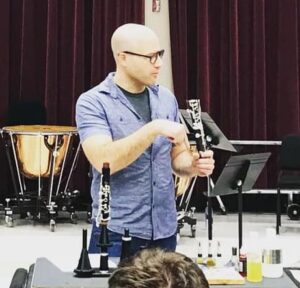
In addition to his position as Instrument Repair Technician at CVPA Jon also runs his own repair business, Goodman Customs Woodwinds. Specializing in clarinet repair techniques, Jon has given clinics at Appalachian State University, Duke University, and UNC Greensboro. Jon is also an active performer as a new music chamber player playing for various groups across the United States, including Atlanta-based GremlinsDuo and Chicago-based Wei Zhongle, and as a classical musician with the New Chicago Chamber Orchestra, the Winston-Salem Symphony, Western Piedmont Symphony, and the Piedmont Wind Symphony.
Fire + Metal = Art in the Foundry
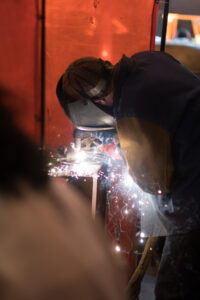
“At first glance, the foundry can be very intimidating. It’s a large space full of big tools, sparks, fire, and loud sounds.”
UNC Greensboro Foundry Director Kevin Vanek says some of the students who enter this space are a little scared that they might not be able to do the work of transforming raw metal into works of art:
“It is my mission to show every student that they can achieve any of their metalworking dreams. Nothing makes me happier than seeing a student grow and become more confident in themselves and their abilities in the shop. Often it’s the students who were the most hesitant who wind up doing the best work.”
CVPA’s foundry and sculpture studio is a spacious outdoor work area on the ground floor of the Maud Gatewood Studio Arts Building. It includes a metal casting area, burn-out kilns for molds and ceramics, and a five-ton indoor/outdoor overhead hoist. Vanek says it’s one of the best shops he’s had the pleasure of working in:
“CVPA’s foundry is very well equipped for working in both cast and fabricated metal sculpture. It has a half dozen high capacity welders, various metal cutting and forming tools, multiple forges, a 155-lb. pneumatic power hammer, a 10,000-lb. capacity bridge crane, and multiple metal furnaces capable of melting up to 660 pounds of bronze at one time. The students in the Art Department are very lucky to have this space. With the capacities of the foundry students can easily create works of art larger than themselves, larger than they ever thought they could produce.”
But, like an artist with his sculpture, Vanek is still refining the foundry, making adjustments to create a more inclusive learning place:
“I’ve made it a personal goal to address issues of accessibility in the shop. Metal working tends to be male dominated. Some of the tools are not usable by all students. I am working to replace and to rebuild outdated equipment in the foundry to better fit the current/future student population. Recently, I ordered all news sets of safety gear for the foundry in all sizes so that all students can safely suit up and fully participate.”
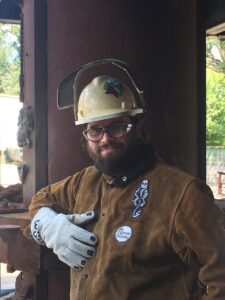
As Foundry Director, Vanek teaches Metal Arts (welding and fabrication) and the Metal Casting Classes. He came to UNC Greensboro in the fall of 2020 from the University of Southern Mississippi (USM) where he was the Studio Technician and an adjunct faculty member in 3D Design, Sculpture, and Foundry. Prior to teaching at USM, Vanek was a Master Fabrication Specialist for Bennett Forgeworks in Ridgeway, Colorado and a Visiting Artist at Colorado Mesa University. He holds an MFA in Sculpture from East Carolina University and a BFA in 3-D Studio Art: Sculpture and Glass from Bowling Green State University.
Story by Terri W. Relos
Photo credit Martin Kane
